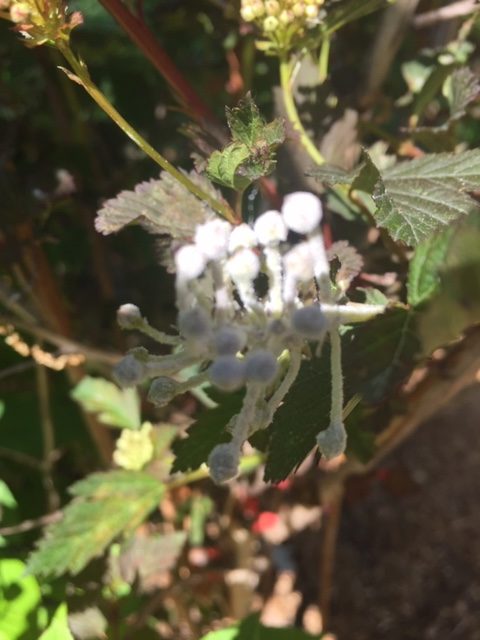For the June Newsletter, I asked Northumberland Master Gardeners to share some of their gardening challenges and to describe the steps they have taken to solve the problems. Interesting enough the problems they shared this time are all related to shrubs and trees:
Joy Cullen shares this problem: I have a Pinus Sylvestris ‘Wolting’s Gold’. The first year in my garden it had an infestation of pine sawflies that stripped a lot of old needles.Now that I know what they are I watch for them each May and treat the infestation easily. The larva hatch when the lilacs bloom.
There are chemical controls but a strong blast from the hose will dislodge them. I find them very early when they are tiny black dots and just squeeze them with a gloved hand.Important to be on lookout for them as they grow quickly and eat voraciously.
Lori Groves tells us about some excellent cultural controls that she implemented to deal with her problem: The three mature blue spruce trees (Picea pungens) growing together in my front yard have Rhizosphaera Needlecast, a fungal disease. The infected needles are being shed starting with those on the lowest branches of the trees and progressing upwards, especially on the north side as expected. The spores spread from the infected needles to newly emerging needles, particularly in wet and humid conditions. The fungal spores can splash in the rain from tree to tree. To overcome this challenge, I have attempted to lessen the tree decline by removing the lowest, most infected branches and then I sanitized the tools I used in 70% alcohol. I plan to cut the turf back even farther away from where the lowest branches extend. In dry weather, I will rake and destroy the dropped needles on which the spores can live. I will ensure that any manual watering of the trees is done with drip irrigation. I plan to continue yearly fertilization in early spring. The addition of shredded bark mulch will provide organic matter to the soil under the trees, help to retain soil moisture, and to reduce weeds. I hope that the trees will recuperate with the implementation of these cultural controls to alter their environment.

Rhizosphaera Needlecast is a fungal disease resulting in sheding of infected needles starting with those on the lowest branches
Tanya Crowell has become overwhelmed with Gypsy Moth Caterpillars. They have been a problem for many gardeners this spring: I’m sad to say the big issue in my garden right now is the Gypsy Moth Caterpillars which are everywhere! Several trees are defoliated. It is so sad. They are after some perennials and have started chewing on green beans and basil in the vegetable garden. I must say I’ve never experienced anything like this before!
We have tried duct tape on the trees, spent last fall and winter destroying egg masses, at least ones we could reach. I’m spraying with BTK as a last resort as I don’t want to lose the ornamentals such as standard sand cherries, dappled willow and amelenchier.
I have no idea if my measures will have any impact! The caterpillars are crawling all over our house too, but luckily, they cannot eat that! Wish me luck!
The following link will take you to an Ontario site about the Gypsy moth, how to recognize it and what you can do to deal with them.
https://www.ontario.ca/page/gypsy-moth
I too have been dealing with a problem with a shrub. My “Diablo” ninebark (Pysocarpus opulifolius) was showing signs of white fungus (powdery mildew). The white fungus presents as a white powdery growth on the surface of the leaves, flowers, and some branches. The solutions were to remove and destroy all the infected plant parts. I followed this by spraying the plant with a solution made up of 4 litres of water mixed with 1 ½ teaspoons of baking soda and 3 tbs of horticultural oil. I am reapplying this solution every two weeks. It is important to carry out these measures as the white fungus is not host specific and can spread to other plants in the garden. It is also important to clean your pruners with alcohol to prevent the spread of the fungus.
Checking often for signs of insect damage or fungal growth on your trees, shrubs and perennials is important. Quick response to these problems can save not only the plant with the problem but other plants in your garden. It is also important to be sure that the plant is planted in the right place with the right growing conditions. A stressed plant becomes a target for problems. If you are confronting a gardening problem, you can reach out to Northumberland Master Gardeners for some help. Click on the “Ask a Master ” button found at the end of the newsletter. A Master Gardener will respond within a few days.

